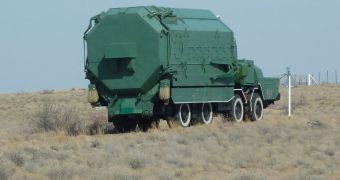Officials at the European Space Agency (ESA) announce on their official website that Europe's newest space mission, the CryoSat-2 satellite, has arrived at its launch site in Kazakhstan. The spacecraft is getting ready for an April 8 launch date, when it is scheduled to blast to space aboard a Dnepr delivery vehicle. The Earth-observations satellite should have already been airborne by now, but a number of glitches on the Russian-built rocket has prevented it from taking off when initially planned.
The ESA satellite and its delivery vehicles have now been mated inside the launch silo which houses the pad these rockets use. There are only two facilities that can handle the launch of these modified Intercontinental Ballistic Missiles (ICBM), and the Baikonur Cosmodrome is one of them. The rockets take off straight from the silo and are not mounted on a conventional, visible launch pad.
The “space head module” that was transported this morning to the silo was picked up from the Baikonur Integration Facility in the early hours of the morning, and mounted in the back of a specialized truck, called the “crocodile.” The upper part of the vehicle opens up like the jaws of a crocodile, allowing for its cargo to be placed in or taken out. The machine took about an hour to complete the 7-kilometer journey from the integration building to the launch site. This is the last time ESA experts will ever see the spacecraft. Operations at the launch site itself are only conducted by proprietary, Russian personnel, and ESA technicians are not allowed access.
“[T]he last milestone before liftoff will be the launch dress rehearsal, planned for Tuesday. This simulation will ensure the communication sequences and procedures between the launch site and ESA's European Space Operations Center in Germany are in place for launch on Thursday. The launch of CryoSat-2 will mark an important milestone for ESA because it will be the third Earth Explorer mission to be placed in orbit within just over 12 months,” ESA experts write.
One of the main reasons why this mission was put together was the fact that the changes happening on the Earth's pole on account of global warming and climate change were beginning to evolve rapidly. Therefore climatologists needed a tool capable of producing sensitive measurements of the regions of interest, covering the recent record-lows in the extent of summer Arctic sea-ice cover. Additionally, scientists also need to be able to determine how the thickness of the ices is changing around the year. A better understanding of these dynamics will contribute to climate-change studies and will provide more variables for computer models.

 14 DAY TRIAL //
14 DAY TRIAL //